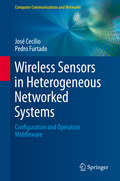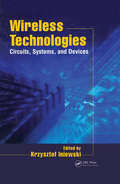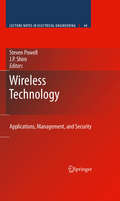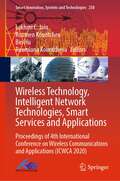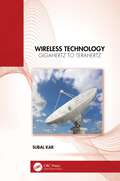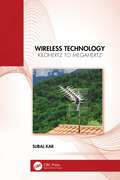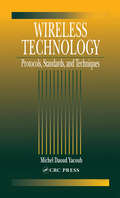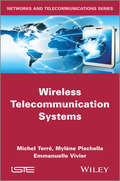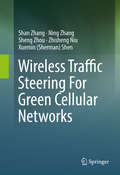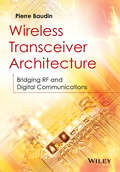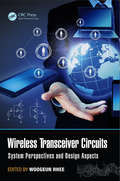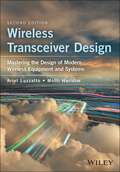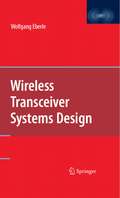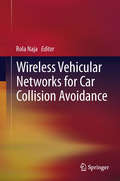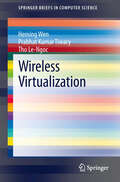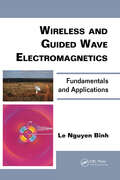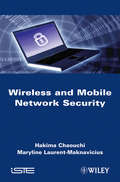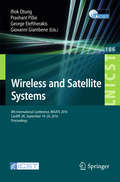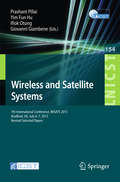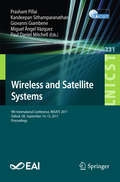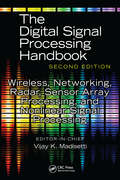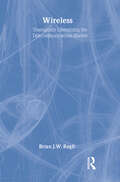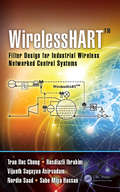- Table View
- List View
Wireless Sensors in Heterogeneous Networked Systems
by José Cecílio Pedro FurtadoThis book presents an examination of the middleware that can be used to configure and operate heterogeneous node platforms and sensor networks. The middleware requirements for a range of application scenarios are compared and analysed. The text then defines middleware architecture that has been integrated in an approach demonstrated live in a refinery. Features: presents a thorough introduction to the major concepts behind wireless sensor networks (WSNs); reviews the various application scenarios and existing middleware solutions for WSNs; discusses the middleware mechanisms necessary for heterogeneous WSNs; provides a detailed examination of platform-agnostic middleware architecture, including important implementation details; investigates the programming paradigms for WSNs, and for heterogeneous sensor networks in general; describes the results of extensive experimentation and testing, demonstrating that the generic architecture is viable for implementation on multiple platforms.
Wireless Technologies: Circuits, Systems, and Devices (Devices, Circuits, and Systems)
by Krzysztof IniewskiAdvanced concepts for wireless technologies present a vision of technology that is embedded in our surroundings and practically invisible. From established radio techniques like GSM, 802.11 or Bluetooth to more emerging technologies, such as Ultra Wide Band and smart dust motes, a common denominator for future progress is the underlying integrated circuit technology. Wireless Technologies responds to the explosive growth of standard cellular radios and radically different wireless applications by presenting new architectural and circuit solutions engineers can use to solve modern design problems.This reference addresses state-of-the art CMOS design in the context of emerging wireless applications, including 3G/4G cellular telephony, wireless sensor networks, and wireless medical application. Written by top international experts specializing in both the IC industry and academia, this carefully edited work uncovers new design opportunities in body area networks, medical implants, satellite communications, automobile radar detection, and wearable electronics.The book is divided into three sections: wireless system perspectives, chip architecture and implementation issues, and devices and technologies used to fabricate wireless integrated circuits. Contributors address key issues in the development of future silicon-based systems, such as scale of integration, ultra-low power dissipation, and the integration of heterogeneous circuit design style and processes onto one substrate.Wireless sensor network systems are now being applied in critical applications in commerce, healthcare, and security. This reference, which contains 25 practical and scientifically rigorous articles, provides the knowledge communications engineers need to design innovative methodologies at the circuit and system level.
Wireless Technology
by Steven Powell J. P. ShimThis is an edited volume based on selected papers from the annual Wireless Telecommunications Symposium. The WTS is a forum to exchange information on advances in mobile communications and wireless networking technology, management, applications, and security in a conference environment with leaders and experts from industry, governmental agencies, and universities around the world. The key topics from the symposium include: 1) Wireless Network Security, 2) Advances in Satellite Communications, 3) New Wireless Communications Ventures, 4) Wireless Communications Investments, 5) Mobile Wireless Services and Business, 6) Future Directions in Wireless Communications Research. The best papers from the conference were selected, expanded, and edited to produce this cohesive volume.
Wireless Technology, Intelligent Network Technologies, Smart Services and Applications: Proceedings of 4th International Conference on Wireless Communications and Applications (ICWCA 2020) (Smart Innovation, Systems and Technologies #258)
by Lakhmi C. Jain Bin Hu Roumen Kountchev Roumiana KountchevaThis book gathers selected papers presented at the 4th International Conference on Wireless Communications and Applications (ICWCA 2020), held at Hainan University, China. The second volume will involve research works aimed at the contemporary applications: emerging wireless/mobile applications, context and location-aware wireless services; wireless telemedicine and e-health services; intelligent transportation systems; RFID technology and application; cognitive radio and sensor-based applications; content distribution in wireless home environment and many others.
Wireless Technology: Gigahertz to Terahertz
by Subal KarThis book covers the active devices, circuits and systems including antennas used in the electromagnetic spectrum for wireless technology in the GHz to THz frequency range. It also includes the whole domain of digital communication techniques and its use in modern electronic communication including those in 5G and the forthcoming 6G mobile communication. The presentation of the book is in a concise yet complete way and stresses the physical and technical aspects with application view-points but using minimum possible mathematics.The book: Discusses the intricate differences and evolution of GHz (i.e. microwaves) to THz devices and circuits including antennas, useful for wireless technology in this higher frequency domain of electromagnetic spectrum, comparing those with their counter parts at lower RF frequency of KHz to MHz. Briefly discusses various wireless systems in the GHz frequency range—both analogue and digital; like RDAR and radio-aids to navigation, satellite communication, mobile communication, GPS and so forth. Highlights the need and usefulness of digital communication and covers various digital modulation techniques like PCM, ASK, FSK, PSK, QAM and also various analogue and digital multiplexing techniques like FDM, TDM, CDM, OFDM, and NOMA useful for modern digital communication. Discusses the new and emerging technology of wireless technology at THz frequency covering signal generation, waveguide and quasi-optic components including sensors and detectors, antennas, channel modelling, T-ray imaging and so forth. Covers the applications of THz for various emerging new applications like concealed weapon detection (CWD), standoff detection of explosives and abusive drugs, medical application of THz including the use of THz in forthcoming 6G mobile communication etc. This overall scenario of developments of wireless technology from GHz to THz frequency domain is expected to attract the interest of students, research scholars, professionals, and even the general readers alike with a new vision to have a quick yet in-depth glimpse of the progress of wireless technology in the modern times. It is primarily written for senior undergraduate students, post-graduate students, and academic researchers in the fields of electrical engineering, electronics and communication engineering, wireless communication, telecommunication, and computer engineering.
Wireless Technology: Kilohertz to Megahertz
by Subal KarThe text contains all the essential elements of communication principles, devices, circuits, antennas, and systems covering the electromagnetic spectrum from KHz to MHz of radio frequency (RF) that was developed in the formative stage of wireless technology. Also, the digital revolution, that has changed the landscape of modern electronics for wireless technology, has been discussed emphasizing the fundamentals including digital computers. The presentation of the book is in a concise yet complete way and stresses the physical and technical aspects with application viewpoints but using minimum possible mathematics.The book: Discusses the historical background of different developments of wireless technology from KHz to MHz and going through the GHz to THz in due perspective to provide a holistic view of the development of wireless technology from its inception to contemporary times. Contains in brief the basic concepts of electromagnetism like Maxwell’s wave equation, evanescent waves, surface waves, plasmonic waves that are used in wireless technology in some form or the other. Highlights the need for modulation and covers various modulation techniques such as continuous wave and pulse analogue modulation and modulation/demodulation systems that were developed in the formative stage of the development of wireless technology in the RF frequency range of KHz to MHz. Discusses the physical concepts and application view-points of active devices, RF transmission lines, antennas and systems used at KHz to MHz frequency domain of wireless technology. Covers the digital revolution that has changed the wholesale electronic systems of modern wireless technology, and the development of digital computers has also been discussed with a brief overview of laptops, supercomputers, and upcoming quantum computers. This overall scenario of historical perspective of wireless technology from KHz to THz and technical developments from KHz to MHz in the RF domain during the formative stage of development of wireless technology including fundamental developments related to digital revolution is expected to attract the interest of the entry level students, research scholars, professionals, and even the general readers alike with a new vision to have a quick yet in-depth glimpse of the progress of wireless technology since its inception till today. It is primarily written for junior undergraduate students in the fields of electrical engineering, electronics and communication engineering, wireless communication, telecommunication, and computer engineering. Research scholars and professionals can also refresh their idea of the developments of wireless technology during its formative stage and can get a flavour of the route to modern developments that have taken place henceforth.
Wireless Technology: Protocols, Standards, and Techniques
by Michel Daoud YacoubVast, complex technologies, countless relevant topics, seemingly limitless documentation of standards and recommendations… In a field as dynamic as wireless technology, how is one to keep up when the very task of deciding which publications to read and which resources belong on your shelf can be daunting?Wireless Technology: Protocols, Standards, and Techniques has sorted it out for you. From basic principles to the state of the art, it furnishes clear, concise descriptions of second and third generation wireless technologies. The bestselling author of the Foundations of Mobile Radio Engineering has gathered together the most up-to-date networking standards, techniques, and protocols and incorporated clear, concise treatments of the necessary background material to form the most current and complete wireless reference available.However bumpy the road may seem, the migration to a wireless world is inevitable. Whether you are a communications engineer, network analyst or designer, electrical engineer, or computer engineer, keeping up in this rapidly evolving field is imperative. This book will help you stay at the forefront of your field and contribute to making the wireless world a reality.
Wireless Telecommunication Systems
by Emmanuelle Vivier Michel Terré Mylène PischellaWireless telecommunication systems generate a huge amount of interest. In the last two decades, these systems have experienced at least three major technological leaps, and it has become impossible to imagine how society was organized without them. In this book, we propose a macroscopic approach on wireless systems, and aim at answering key questions about power, data rates, multiple access, cellular engineering and access networks architectures. We present a series of solved problems, whose objective is to establish the main elements of a global link budget in several radiocommunications systems. Contents 1. Radio Propagation. 2. F/TDMA and GSM. 3. CDMA and UMTS. 4. OFDM and LTE. 5. MIMO and Beamforming. 6. UWB. 7. Synchronization. 8. Digital Communications Fundamentals. 9. Erlang B Tables. About the Authors Michel Terré received his engineering degree from Télécom SudParis, his phD in electronics and telecommunications from Conservatoire National des Arts et Métiers (CNAM), and his habilitation to conduct researches from Paris XIII University. He is a full professor at Conservatoire National des Arts et Métiers. He his responsabile of CNAM’s Master of Science in radiocommunicationssystems. Mylène Pischella received her engineering degree and her phD in electronics and telecommunications from Télécom ParisTech. She is an associate professor at Conservatoire National des Arts et Métiers (CNAM). Emmanuelle Vivier received her engineering degree from Institut Supérieur d’Electronique de Paris (ISEP) and her PhD in radiocommunications from Conservatoire National des Arts et Métiers (CNAM). She is an associate professor at ISEP, where she is responsible of networks and telecommunications teaching majors.
Wireless Traffic Steering For Green Cellular Networks
by Ning Zhang Xuemin Sherman Shen Sheng Zhou Zhisheng Niu Shan ZhangThis book introduces wireless traffic steering as a paradigm to realize green communication in multi-tier heterogeneous cellular networks. By matching network resources and dynamic mobile traffic demand, traffic steering helps to reduce on-grid power consumption with on-demand services provided. This book reviews existing solutions from the perspectives of energy consumption reduction and renewable energy harvesting. Specifically, it explains how traffic steering can improve energy efficiency through intelligent traffic-resource matching. Several promising traffic steering approaches for dynamic network planning and renewable energy demand-supply balancing are discussed. This book presents an energy-aware traffic steering method for networks with energy harvesting, which optimizes the traffic allocated to each cell based on the renewable energy status. Renewable energy demand-supply balancing is a key factor in energy dynamics, aimed at enhancing renewable energy sustainability to reduce on-grid energy consumption. Dynamic network planning adjusts cell density with traffic variations to provide on-demand service, which reduces network power consumption with quality of service provisioning during off-peak hours. With intra- or inter-tier traffic steering, cell density is dynamically optimized with regards to the instant traffic load for conventional homogeneous and multi-tier heterogeneous cellular networks, respectively. This book is beneficial for researchers and graduate students interested in traffic management and future wireless networking.
Wireless Transceiver Architecture: Bridging RF and Digital Communications
by Pierre BaudinA fully comprehensive reference combining digital communications and RFIC (Radio Frequency Integrated Circuits) in one complete volume There are many books which focus on the physical implementation of the RF/analog part of transceivers, such as the CMOS design, or the signal processing involved in digital communications. However, there islittle material dedicated to transceiver architecture and system design. Similarly, much of the existing literature looks at concepts useful for dimensioning, yet offers little practical information on how to proceed for dimensioning a line-up from scratch, and on the reasons for proceeding that way. This book redresses the balance by explaining the architecture of transceivers and their dimensioning from the perspective of a RFIC architect from within industry. It bridges the gap between digital communication systems and radiofrequency integrated circuit design, covering wireless transceiver architecture and system design from both system level and circuit designer aspects. • Covers digital communication theory, electromagnetism theory and wireless networks organization, from theories to implementation, for deriving the minimum set of constraints to be fulfilled by transceivers • Details the limitations in the physical implementation of transceivers to be considered for their dimensioning, in terms of noise, nonlinearity, and RF impairments • Presents transceiver architecture and system design in terms of transceivers budgets, transceivers architectures, and algorithms for transceivers
Wireless Transceiver Circuits: System Perspectives and Design Aspects (Devices, Circuits, and Systems)
by Krzysztof Iniewski Woogeun RheeModern transceiver systems require diversified design aspects as various radio and sensor applications have emerged. Choosing the right architecture and understanding interference and linearity issues are important for multi-standard cellular transceivers and software-defined radios. A millimeter-wave complementary metal–oxide–semiconductor (CMOS) transceiver design for multi-Gb/s data transmission is another challenging area. Energy-efficient short-range radios for body area networks and sensor networks have recently received great attention. To meet different design requirements, gaining good system perspectives is important.Wireless Transceiver Circuits: System Perspectives and Design Aspects offers an in-depth look at integrated circuit (IC) design for modern transceiver circuits and wireless systems. Ranging in scope from system perspectives to practical circuit design for emerging wireless applications, this cutting-edge book: Provides system design considerations in modern transceiver design Covers both systems and circuits for the millimeter-wave transceiver design Introduces four energy-efficient short-range radios for biomedical and wireless connectivity applications Emphasizes key building blocks in modern transceivers and transmitters, including frequency synthesizers and digital-intensive phase modulators Featuring contributions from renowned international experts in industry and academia, Wireless Transceiver Circuits: System Perspectives and Design Aspects makes an ideal reference for engineers and researchers in the area of wireless systems and circuits.
Wireless Transceiver Design: Mastering the Design of Modern Wireless Equipment and Systems
by Motti Haridim Ariel LuzzattoBuilding upon the success of the first edition (2007), Wireless Transceiver Design 2nd Edition is an accessible textbook that explains the concepts of wireless transceiver design in detail. The architectures and the detailed design of both traditional and advanced all-digital wireless transceivers are discussed in a thorough and systematic manner, while carefully watching out for clarity and simplicity. Many practical examples and solved problems at the end of each chapter allow students to thoroughly understand the mechanisms involved, to build confidence, and enable them to readily make correct and practical use of the applicable results and formulas. From the instructors' perspective, the book will enable the reader to build courses at different levels of depth, starting from the basic understanding, whilst allowing them to focus on particular elements of study. In addition to numerous fully-solved exercises, the authors include actual exemplary examination papers for instructors to use as a reference format for student evaluation. The new edition has been adapted with instructors/lecturers, graduate/undergraduate students and RF engineers in mind. Non-RF engineers looking to acquire a basic understanding of the main related RF subjects will also find the book invaluable.
Wireless Transceiver Systems Design
by Wolfgang EberleThe fields of communication, signal processing, and embedded systems and circuits are brought together in this book. These fields come together with a single design goal, a WLAN transceiver which combines analog and digital design, VLSI and systems design, algorithms and architectures, as well as design and CAD/EDA. This book focuses on the overall approach to design problems and design organization needed for transceiver design. It does not focus on one particular standard.
Wireless Vehicular Networks for Car Collision Avoidance
by Rola NajaWireless Vehicular Networks for Car Collision Avoidance focuses on the development of the ITS (Intelligent Transportation Systems) in order to minimize vehicular accidents. The book presents and analyses a range of concrete accident scenarios while examining the causes of vehicular collision and proposing countermeasures based on wireless vehicular networks.The book also describes the vehicular network standards and quality of service mechanisms focusing on improving critical dissemination of safety information. With recommendations on techniques and protocols to consider when improving road safety policies in order to minimize crashes and collision risks.
Wireless Virtualization
by Tho Le-Ngoc Heming Wen Prabhat Kumar TiwaryThis SpringerBriefs is an overview of the emerging field of wireless access and mobile network virtualization. It provides a clear and relevant picture of the current virtualization trends in wireless technologies by summarizing and comparing different architectures, techniques and technologies applicable to a future virtualized wireless network infrastructure. The readers are exposed to a short walkthrough of the future Internet initiative and network virtualization technologies in order to understand the potential role of wireless virtualization in the broader context of next-generation ubiquitous networks. Three main wireless virtualization perspectives are explored, along with the potential challenges and requirements of a sustainable wireless virtualization framework. Finally, it presents an example of a multi-perspective wireless virtualization framework. The readers learn the latest concepts in the application of wireless virtualization as well as its relationship with cutting-edge wireless technologies such as software-defined radio (SDR) and cognitive radio.
Wireless Wars: China's Dangerous Domination of 5G and How We're Fighting Back
by Jonathan PelsonA 2024 US AIR FORCE LEADERSHIP LIBRARY BOOK NATIONAL INDIE EXCELLENCE AWARDS WINNER — TECHNOLOGY As the world rolls out transformational 5G services, it has become increasingly clear that China may be able to disrupt—or even access—the wireless networks that carry our medical, financial, and even military communications. This insider story from a telecommunications veteran uncovers how we got into this mess—and how to change the outcome. In Wireless Wars: China's Dangerous Domination of 5G and How We're Fighting Back, author Jon Pelson explains how America invented cellular technology, taught China how to make the gear, and then handed them the market. Pelson shares never-before-told stories from the executives and scientists who built the industry and describes how China undercut and destroyed competing equipment makers, freeing themselves to export their nation&’s network gear—and their surveillance state. He also reveals China&’s successful program to purchase the support of the world&’s leading political, business, and military figures in their effort to control rival nations&’ networks. What&’s more, Pelson draws on his lifelong experience in the telecommunications industry and remarkable access to the sector&’s leaders to reveal how innovative companies can take on the Chinese threat and work with counterintelligence and cybersecurity experts to prevent China from closing the trap. He offers unparalleled insights into how 5G impacts businesses, national security and you. Finally, Wireless Wars proposes how America can use its own unique superpower to retake the lead from China. This book is about more than just 5G wireless services, which enable self-driving cars, advanced telemedicine, and transformational industrial capabilities. It&’s about the dangers of placing our most sensitive information into the hands of foreign companies who answer to the Chinese Communist Party. And it&’s about the technology giant that China is using to project its power around the world; Huawei, a global super-company that has surged from a local vendor to a $120 billion-a-year behemoth in just a few years. For anyone curious about the hottest issue at the intersection of technology and geopolitics, Wireless Wars offers an immersive crash course and an unforgettable read.
Wireless and Guided Wave Electromagnetics: Fundamentals and Applications (Optics and Photonics)
by Le BinhWireless communications allow high-speed mobile access to a global Internet based on ultra-wideband backbone intercontinental and terrestrial networks. Both of these environments support the carrying of information via electromagnetic waves that are wireless (in free air) or guided through optical fibers. Wireless and Guided Wave Electromagnetics: Fundamentals and Applications explores the fundamental aspects of electromagnetic waves in wireless media and wired guided media. This is an essential subject for engineers and physicists working with communication technologies, mobile networks, and optical communications. This comprehensive book: Builds from the basics to modern topics in electromagnetics for wireless and optical fiber communication Examines wireless radiation and the guiding of optical waves, which are crucial for carrying high-speed information in long-reach optical networking scenarios Explains the physical phenomena and practical aspects of guiding optical waves that may not require detailed electromagnetic solutions Explores applications of electromagnetic waves in optical communication systems and networks based on frequency domain transfer functions in the linear regions, which simplifies the physical complexity of the waves but still allows them to be examined from a system engineering perspective Uses MATLAB® and Simulink® models to simulate and illustrate the electromagnetic fields Includes worked examples, laboratory exercises, and problem sets to test understanding The book’s modular structure makes it suitable for a variety of courses, for self-study, or as a resource for research and development. Throughout, the author emphasizes issues commonly faced by engineers. Going a step beyond traditional electromagnetics textbooks, this book highlights specific uses of electromagnetic waves with a focus on the wireless and optical technologies that are increasingly important for high-speed transmission over very long distances.
Wireless and Mobile Network Security: Proceedings Of The Mwns 2008 Workshop, Singapore, 9 April 2008
by Hakima Chaouchi Maryline Laurent-MaknaviciusThis book provides a thorough examination and analysis of cutting-edge research and security solutions in wireless and mobile networks. It begins with coverage of the basic security concepts and fundamentals which underpin and provide the knowledge necessary for understanding and evaluating security issues, challenges, and solutions. This material will be of invaluable use to all those working in the network security field, and especially to the many people entering the field. The next area of focus is on the security issues and available solutions associated with off-the-shelf wireless and mobile technologies such as Bluetooth, WiFi, WiMax, 2G, and 3G. There is coverage of the security techniques used to protect applications downloaded by mobile terminals through mobile cellular networks, and finally the book addresses security issues and solutions in emerging wireless and mobile technologies such as ad hoc and sensor networks, cellular 4G and IMS networks.
Wireless and Satellite Systems
by Giovanni Giambene Prashant Pillai Ifiok Otung George EleftherakisThis book constitutes the proceedings of the 7thInternational Conference on Wireless and Satellite Services, WiSATS 2015, heldin Bradford, UK, in July 2015. The conference was formerly known as theInternational Conference on Personal Satellite Services (PSATS) mainly coveringtopics in the satellite domain. As the scope of the conference widened toinclude wireless systems, the conference was renamed to WiSATS. The 29 revised papers were presented at theconference in three technical sessions and one special session on "Network Codingfor Satellites". WiSATS 2015 also hosted two workshops along with the mainconference: The first workshop, Communication Applications in Smart Grid (CASG2015), focused on the merging area of using communication technology within theelectricity power grid for smart monitoring and control. The second workshop,Advanced Next-Generation Broadband Satellite Systems (BSS 2015), focused on theuse of satellite systems for providing next-generation broadbandservices.
Wireless and Satellite Systems
by Giovanni Giambene Prashant Pillai Yim Fun Hu Ifiok OtungThis book constitutes the proceedings of the 7thInternational Conference on Wireless and Satellite Services, WiSATS 2015, heldin Bradford, UK, in July 2015. The conference was formerly known as theInternational Conference on Personal Satellite Services (PSATS) mainly coveringtopics in the satellite domain. As the scope of the conference widened toinclude wireless systems, the conference was renamed to WiSATS. The 29 revised papers were presented at theconference in three technical sessions and one special session on "Network Codingfor Satellites". WiSATS 2015 also hosted two workshops along with the mainconference: The first workshop, Communication Applications in Smart Grid (CASG2015), focused on the merging area of using communication technology within theelectricity power grid for smart monitoring and control. The second workshop,Advanced Next-Generation Broadband Satellite Systems (BSS 2015), focused on theuse of satellite systems for providing next-generation broadbandservices.
Wireless and Satellite Systems: 8th International Conference, Wisats 2016, Cardiff, Uk, September 19-20, 2016, Revised Selected Papers (Lecture Notes Of The Institute For Computer Sciences, Social-informatics And Telecommunications Engineering Ser. #186)
by Giovanni Giambene Prashant Pillai Kandeepan Sithamparanathan Miguel Ángel Vázquez Paul Daniel MitchellThis book constitutes the proceedings of the 9th International Conference on Wireless and Satellite Services, WiSATS 2017, held in Oxford, UK, in September 2017. The conference was formerly known as the International Conference on Personal Satellite Services (PSATS) mainly covering topics in the satellite domain. The aim of this conference is to bring together researchers, developers and practitioners from around the world in the field of wireless and satellite systems. The theme of WiSATS 2017 was on the means of using the wireless and satellite services directly to the user for personal communications, multimedia and location identification.
Wireless, Networking, Radar, Sensor Array Processing, and Nonlinear Signal Processing (The Digital Signal Processing Handbook, Second Edition)
by Vijay MadisettiNow available in a three-volume set, this updated and expanded edition of the bestselling The Digital Signal Processing Handbook continues to provide the engineering community with authoritative coverage of the fundamental and specialized aspects of information-bearing signals in digital form. Encompassing essential background material, technical details, standards, and software, the second edition reflects cutting-edge information on signal processing algorithms and protocols related to speech, audio, multimedia, and video processing technology associated with standards ranging from WiMax to MP3 audio, low-power/high-performance DSPs, color image processing, and chips on video. Drawing on the experience of leading engineers, researchers, and scholars, the three-volume set contains 29 new chapters that address multimedia and Internet technologies, tomography, radar systems, architecture, standards, and future applications in speech, acoustics, video, radar, and telecommunications.This volume, Wireless, Networking, Radar, Sensor Array Processing, and Nonlinear Signal Processing, provides complete coverage of the foundations of signal processing related to wireless, radar, space–time coding, and mobile communications, together with associated applications to networking, storage, and communications.
Wireless-Powered Communication Networks: Architectures, Protocols, and Applications
by Dusit Niyato Ekram Hossain Dong In Kim Vijay Bhargava Lotfollah ShafaiLearn the fundamentals of architecture design, protocol optimization, and application development for wireless-powered communication networks with this authoritative guide. Readers will gain a detailed understanding of the issues surrounding architecture and protocol design, with key topics covered including relay-based energy harvesting systems, multiple-antenna systems for simultaneous wireless information and power transfer (SWIPT), performance modeling and analysis, and ambient wireless energy harvesting based cellular systems. Current applications of energy harvesting and transfer in different wireless networking scenarios are discussed, aiding the understanding of practical system development and implementation issues from an engineering perspective. The first book to provide a unified view of energy harvesting and wireless power transfer networks from a communications perspective, this is an essential text for researchers working on wireless communication networks and wireless systems, RF engineers, and wireless application developers.
Wireless: Strategically Liberalizing the Telecommunications Market (Lea Telecommunications Ser.)
by Brian J.W. RegliThe revolution of wireless communications has only just begun to transform the telecommunications industry worldwide. This book offers insight into the possible options for corporate strategists and government policymakers as they look to harness the expansion of wireless communications to meet the goals of sustainable telecommunications development. Using a multidisciplinary approach which combines policy research, legal analysis, business economics, and models of sustainability from the environmental sciences, the book compares the development of wireless communications in four countries: the United States, the United Kingdom, Russia, and Brazil. The comparative analysis points to common themes and opportunities, including: * breaking down the barriers between wireless and wireline access by changing the regulatory design which constrains service providers; * targeting the development potential of wireless access through the utilization of new technologies and service models; and * using wireless access as the basis for full facilities-based competition in both developing and developed world markets. No other book today offers this broad a context for a discussion of wireless communications and its potential impact on the evolution of the telecommunications industry.
WirelessHART™: Filter Design for Industrial Wireless Networked Control Systems
by Nordin Saad Rosdiazli Ibrahim Tran Duc Chung Vijanth Sagayan Asirvadam Sabo Miya HassanThis book presents a guideline for EWMA filter design for industrial wireless networked control system, both theoretically and practically. The filter’s key advantages are simple, effective, low computational overhead. This book also provides a guideline for practical implementation of EWMA filter for improving networked control performance of various process plants. It further discusses not only the advantages of the filter, but also the limitations and how to avoid them when implementing the filter from practical point of view.
